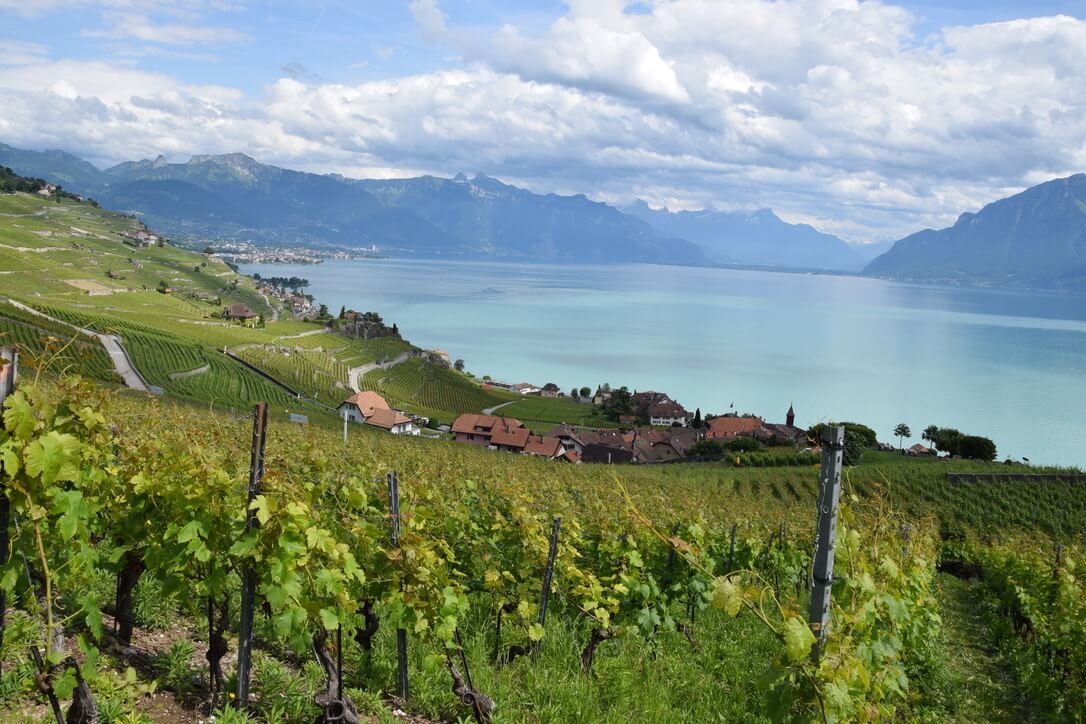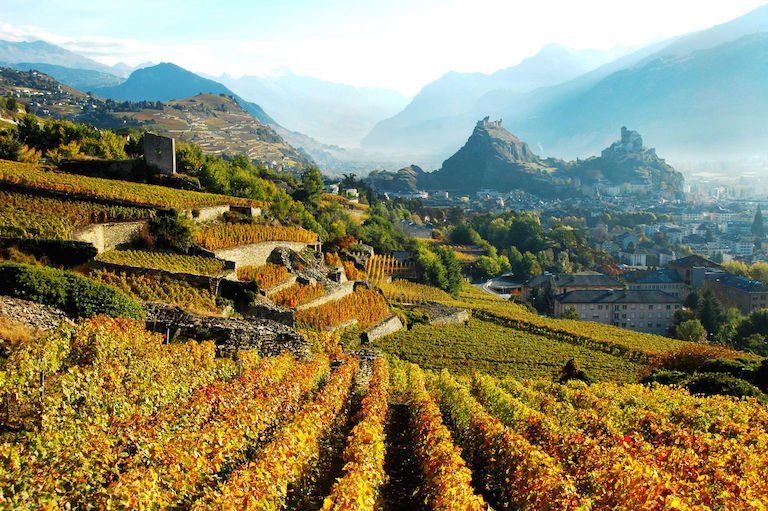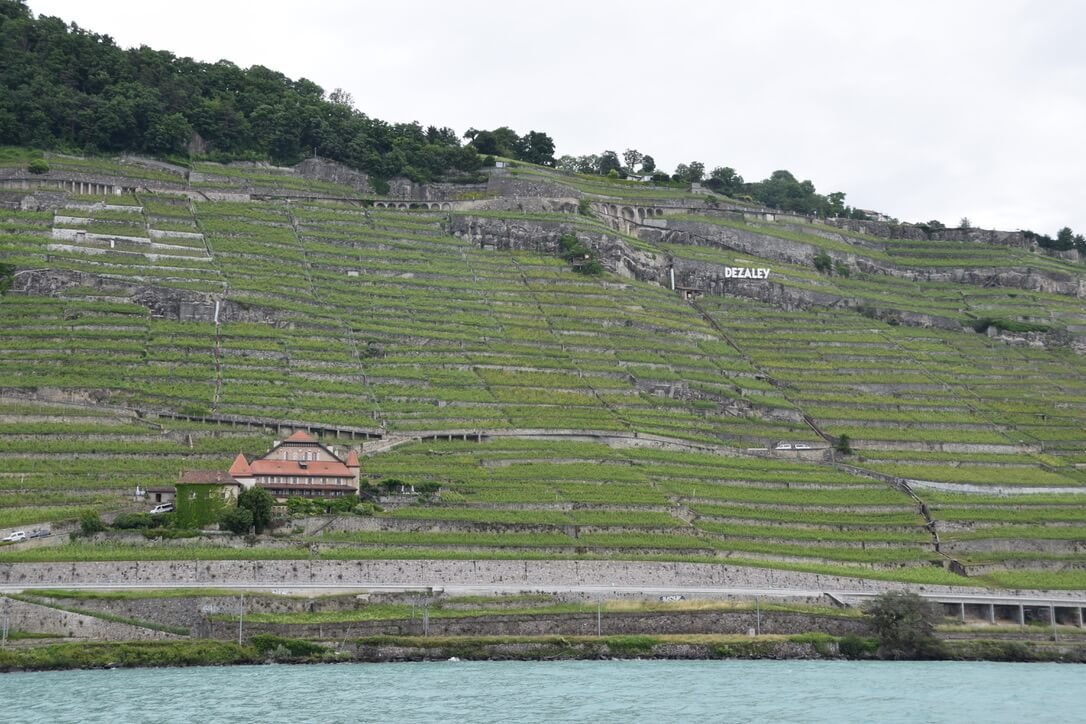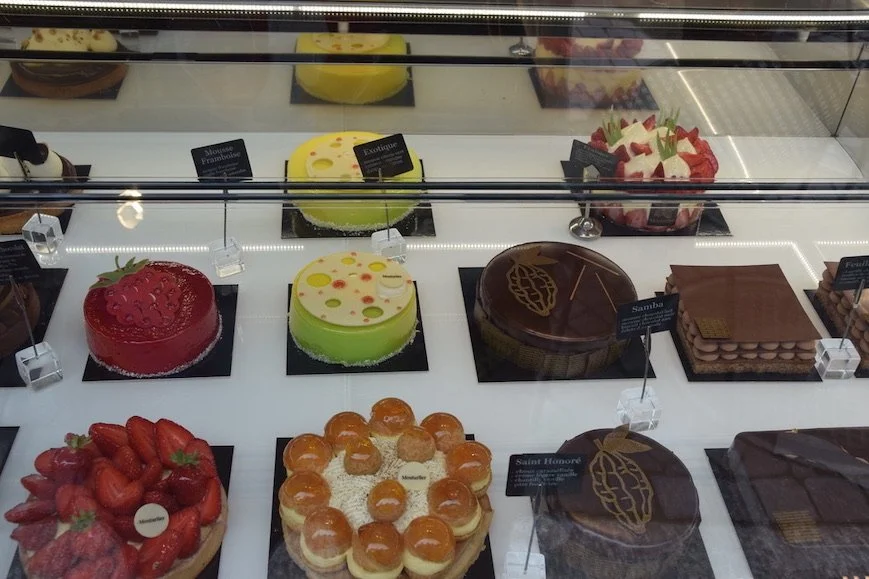WINE REGIONS IN SWITZERLAND

The world heritage Lavaux vineyards on Lake Geneva in the Vaud wine region
Source: Winekeller
Select a wine region in Switzerland for your next wine tour:
Is Switzerland a wine country?
Yes!!
Known the world over for its watches, chocolate, cheese and stunning scenery - as well perhaps for its banking sector, neutrality in global conflict, efficiency and high quality of life, Switzerland is probably not a wine country which comes quickly to mind.
However, Switzerland produces some excellent wines and offers some incredible wine tourism experiences in some of the world’s most beautiful and locations.
Switzerland, a land-locked Alpine country in Central Europe, bordered by Italy, France, Germany, Austria and Liechtenstein, may be a small country in size (8 million inhabitants), but it certainly packs a punch in terms of what it can offer the visiting tourist, both as a Summer destination and a Winter sports destination. It is an incredibly diverse country with idyllic landscapes, Alpine mountains, Mediterranean-style resorts, magnificent lakes and rivers, historic old cities and modern, urban centres.
Also, Lausanne, on Lake Geneva, is part of the ‘Great Wine Capitals’ global network. Not only is Lausanne the ‘Olympic capital’ and one of Europe’s greenest cities, it is surrounded by some of Switzerland’s most stunning, ‘Unesco World Heritage’ vineyards.

Graubünden vineyards in the German-speaking Swiss wine region
Source: Winekeller
Wine regions in Switzerland:
For some context, Switzerland is a federal republic made up of 26 different ‘cantons’. There is no Swiss capital as such, but the federal authorities are based in the city of Bern.
Geographically, Switzerland is divided between the Swiss plateau, the Alps and the Jura and is a collection of many different micro-climates and soils. There are 4 main linguistic and cultural regions: German-speaking Switzerland, French-speaking Switzerland, Italian-speaking Switzerland and ‘Romansh’ - a language spoken predominantly in the Swiss canton of the Grisons (Graubünden).
In terms of Swiss wine regions, they also reflect this geographic, regional and cultural diversity. The 26 Swiss cantons all produce wine, to a varying degree and are grouped into 6 specific wine regions, each with its own unique identity. Across the wine regions there are also 62 different wine AOCs/appellations and these are controlled by each separate canton. So for such a small wine producing country (0.2% of the world’s total wine produced), there are lots of different wines and wine regions to discover!
Switzerland has some 15,000 hectares of vineyards, spread over the 6 different wine regions, with vines grown at every altitude, many on terraces and many overlooking a lake or a river. Switzerland has some of the highest vineyards in Europe and is home to the first vineyards on the 2 great European wine rivers, the Rhône and the Rhine.
The vineyards are spread over the six different wine regions as follows:
Switzerland wine regions map - Source: Swiss Wine
Valais - (32%) - In French-speaking Switzerland, in the south-west of the country in the heart of the Alps and the upper Rhône Valley, this region is mostly made up of terraced vineyards on south-facing slopes;
Vaud - (26%) - Also in French-speaking Switzerland, round the northern shore of Lake Geneva, (or Lac Léman), extending to Lake Neuchâtel, with 8 AOCs, including 2 grand-cru AOCs - known as the home of the white Chasselas grape (see later);
German-speaking Switzerland - or Deutschschweiz - (18%) - There are 17 German-speaking cantons in Switzerland and almost 80% of the wine produced here is red wine. Most of the vineyards are along the Rhine Valley and around Zurich and Schaffhausen (bordering with Germany’s Baden region);
Geneva - (9%) - Where the Jura and the Alps meet, the vineyards around the city of Geneva at the south-western end of the lake are much flatter than those of the Valais and Vaud and benefit from good sunlight;
Ticino - (8%) - The canton of Ticino on the southern side of the Alps facing Italy produces mostly Merlot red wine (80% of production);
Trois-Lacs/3 Lakes (Neuchâtel) - (7%) - This region is divided into 3 distinct entities, with vineyards around the lakes of Neuchâtel, Morat and Bienne.

Valais vineyards, Switzerland
Source: Valais.ch
Swiss wine
Switzerland produces some 100 million litres of wine per year and almost all of it is consumed locally - only about 1% of production is exported - which is why if you haven’t travelled to Switzerland, you may not be familiar with Swiss wines!
The quality of wines from Switzerland really started to improve some 20 years ago, when import restrictions were lifted and Switzerland could import wines into the home market. Today the overall standard is very good and Switzerland produces some unique wines which compete well on the world stage.
Swiss wine types
There are incredibly over 250 grape varieties in Switzerland, but only 4 varieties make up 66% of the vineyard area - Pinot Noir, Gamay and Merlot and the local white grape variety, Chasselas. Red wines make up 57% of the total and 43% white.
The most planted grape variety is Pinot Noir (Blauburgunder in Swiss German), accounting for 29% of vines planted.
In terms of white wine in Switzerland the main grape variety planted and the 2nd most important variety in Switzerland, is ‘Chasselas’ (also known as Gutedel in the German-speaking region or Fendant in Valais). In the German-speaking region however, Müller-thurgau, (known as Riesling-Silvaner or Riesling-Sylvaner), is the most common white grape variety.
Swiss wine culture
For such a small wine-producing country, the Swiss wine culture is impressive and deeply rooted, with its origins stretching back to Roman times. There are some 2,500 family wineries in Switzerland today who ensure that the tradition of winegrowing is maintained and developed. The average number of hectares per winery is small and the focus is on producing high quality, unique wines. Increasingly more wineries are following organic practices and processes.
For everything about Swiss wine, visit swisswine.com

The historic Dezaley terraced vineyard plots in Lavaux
Source: Winekeller
What is the Swiss national food?
Switzerland is a gourmet paradise, with influences from German, French and Italian cuisines and where the national dishes mainly comprise regional specialities.
Popular national dishes include cheese fondue (melted cheese with bread cubes), raclette (melted cheese served with a variety of other foods including potatoes, onions, peppers etc), rösti (a potato cake fried in butter), älplermagronen (a gratin made of potatoes, macaroni, cheese, cream and onions with stewed apple on the side).
Switzerland is also known for the breakfast dish, Birchermüesli, Swiss chocolate and of course Swiss cheese, the foundation of many Swiss dishes! The quality of Swiss cheeses comes down to the quality of the milk and the grass on the Swiss Alpine pastures and there are many, many different Swiss regional cheeses, in addition to the world-famous Gruyère, Emmental and Appenzeller cheeses.
Also, the Swiss love their patisserie - with a good coffee or hot chocolate!
Find out about some local, regional specialties and how best to combine Swiss wine and food.
Swiss cheese fondue (Jonathan Viey/Vaud Promotion)
Swiss Rösti potato cake
Swiss patisserie
Visiting Switzerland
Switzerland is such a diverse, beautiful country, there is something for every visitor - whether you are seeking a Summer destination, a Winter destination or a Family destination, there are many spectacular attractions to enjoy and places to experience. Whether it's outdoor activities you’re looking for, or stunning scenery, or art and culture, there is really something for everyone.
There’s lots to enjoy in the country’s major cities, including Zurich, Geneva, Basel, Lausanne and Lucerne.
Travel to and around Switzerland
Switzerland’s main airports - Zurich, Geneva, Basel and Bern are well supported by international airlines and the country is very well connected from across Europe by train.
Public transport - Swiss Travel Pass
We can highly recommend purchasing a Swiss Travel Pass which gives you unlimited travel by train, bus and boat. If you plan on exploring, this saves you time, money and hassle - and travelling in Switzerland is easy, efficient and enjoyable!
Travelling by car
Travelling by car can be a great way to explore Switzerland - and offers the flexibility to discover the incredible Alpine passes.
If you are planning to drive to Switzerland, a key point to note is that you must purchase a motorway vignette - this is essentially a one off charge for the duration of your stay to cover motorway toll charges. You can purchase this vignette at the border when you enter Switzerland or you can buy it in advance - see here for details.
Make sure you’re well informed about driving in Switzerland - see here for all the information you need.
Is Switzerland very expensive?
The common perception is that for the visitor, Switzerland is expensive compared to travel in other European countries and yes, in our experience it is generally more expensive. This is mainly because of the strength of the currency, the Swiss franc and the relatively high quality of life in Switzerland, which naturally translates to higher prices for the tourist visitor, for example for food and drinks and accommodation. However, our recommendation is to not let that deter you as you can search and find good value for money options - and our experience is that the service and hospitality in Switzerland is excellent.
Visit myswitzerland.com for everything you need to know about planning a trip to Switzerland!
Lake Geneva (LT/ www.diapo.ch)
Beautiful Lausanne (LT/ www.diapo.ch)
Zurich (Switzerland Tourism)






